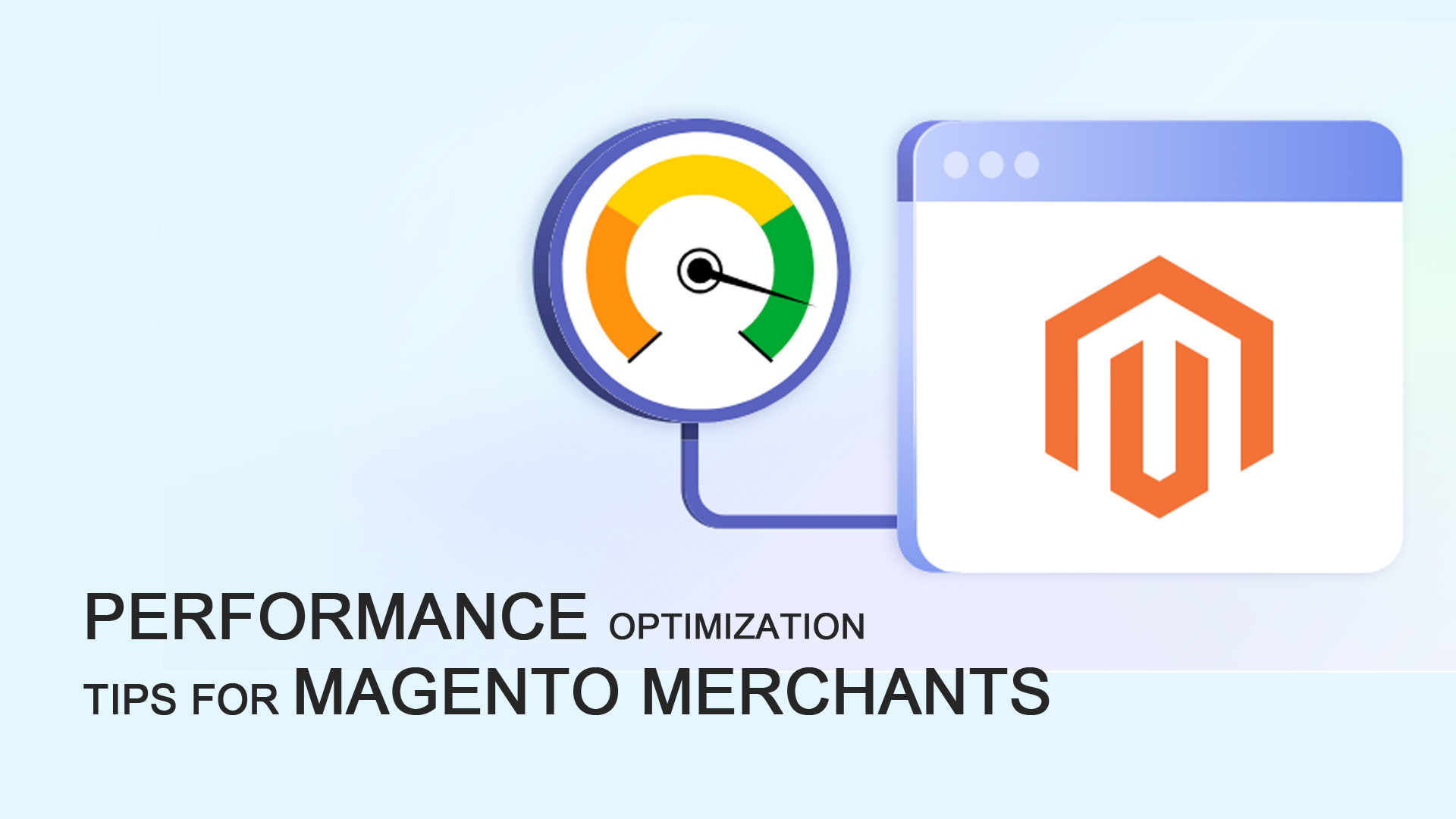Performance Optimization Tips for Magento Merchants
Why Magento Performance Matters
A fast Magento store improves user experience, SEO rankings, and conversions. Slow websites frustrate visitors and reduce sales. Learn more about Magento’s official performance best practices here.
1. Choose a Reliable Hosting Provider
Pick a host with Magento-optimized servers, SSD storage, and good support.
2. Enable Full-Page Caching
Magento’s built-in full-page caching speeds up page loads for returning visitors.
3. Optimize Images and Media Files
Compress and resize images to reduce load time without sacrificing quality.
4. Use a Content Delivery Network (CDN)
CDNs deliver your content faster by using servers closer to your customers.
5. Minify CSS and JavaScript Files
Remove unnecessary characters and spaces to make files smaller and faster to load.
6. Implement Lazy Loading
Load images and videos only when they enter the user’s viewport, saving bandwidth.
7. Keep Magento and Extensions Updated
Regular updates ensure security patches and performance improvements.
8. Optimize Your Database Regularly
Clean up logs and unused data to keep your database lean and fast.
9. Monitor Performance with Tools
Use tools like Google PageSpeed Insights, GTmetrix, or Pingdom to check your site speed.
10. Hire Magento Performance Experts
If performance issues persist, get help from certified Magento developers.
Conclusion
By applying these tips, you can ensure your Magento store stays fast, user-friendly, and ready to convert visitors into loyal customers.
FAQs
How do I speed up my Magento website?
You can boost Magento speed by using full-page caching, optimizing images, using a CDN, and keeping your site updated.
Which hosting is best for Magento performance?
Choose a hosting provider that offers dedicated Magento hosting, SSD storage, and built-in caching. Examples include Nexcess, Cloudways, or SiteGround.
Why is my Magento store slow?
Common reasons are large unoptimized images, poor hosting, outdated extensions, or not using caching/CDN. Regular maintenance helps fix these issues.
In the lightning-fast world of e-commerce, speed isn’t just a luxury – it’s a necessity. For Magento merchants, particularly in a mobile-first market like India, where users expect instantaneous load times even on varying network conditions, every millisecond counts. A slow-loading store can lead to high bounce rates, abandoned carts, lower search engine rankings, and ultimately, significant revenue loss.
Google’s Core Web Vitals (Largest Contentful Paint, Interaction to Next Paint, and Cumulative Layout Shift) are no longer just suggestions; they are crucial ranking factors that directly impact your visibility and user experience. Mastering Magento performance optimization is therefore not just about improving your website’s technical health, but about directly impacting your bottom line and competitive standing in 2025.
This comprehensive guide will walk you through the essential performance optimization tips for your Magento store, covering everything from server configurations to front-end tweaks and ongoing maintenance.
Why Speed Matters More Than Ever for Magento Stores
- User Experience (UX): Modern customers have zero patience for slow websites. A delay of just a few seconds can lead to frustration and a direct exit from your site.
- Conversion Rates: Faster loading times directly correlate with higher conversion rates. A seamless shopping journey from product discovery to checkout encourages purchases.
- SEO Rankings: Google heavily prioritizes website speed. Better Core Web Vitals scores mean higher search engine rankings, more organic traffic, and increased visibility.
- Mobile-First Dominance: In India, a significant portion of e-commerce traffic comes from mobile devices. Optimizing for speed on mobile is paramount to cater to this massive user base.
- Reduced Server Load: An optimized Magento store requires fewer server resources, leading to lower hosting costs and better stability during peak traffic.
Core Strategies for Magento Performance Optimization
Optimizing Magento performance is a multi-faceted approach, covering server-side, database, and front-end aspects.
1. Server & Hosting Optimization: The Foundation
Your hosting environment is the bedrock of your Magento store’s performance.
- Choose a Reputable, Magento-Optimized Host: Avoid generic shared hosting. Invest in a managed Magento hosting provider (or Adobe Commerce Cloud for enterprise). These providers offer environments specifically tuned for Magento, often including pre-configured caching, optimized PHP settings, and robust server resources. Look for providers with data centers strategically located to serve your Indian customer base efficiently.
- Adequate Server Resources (RAM & CPU): Magento is resource-intensive. Ensure your server has sufficient RAM (at least 8GB for a growing store, more for large catalogs and high traffic) and a powerful CPU. Skimping here is a false economy.
- NGINX over Apache: While Magento supports both, NGINX is generally preferred for its superior performance in serving static content and handling concurrent connections, making it ideal for e-commerce.
- Latest PHP Version: Always run the latest stable and supported PHP version (e.g., PHP 8.2 or newer as of 2025). Each new PHP version brings significant performance improvements and better memory management. Ensure your hosting provider supports this and update your Magento application accordingly.
- PHP-FPM: Use PHP-FPM (FastCGI Process Manager) for faster PHP execution and better resource utilization compared to traditional PHP-CGI.
- Enable OPCache: PHP OPCache compiles PHP scripts into bytecode, reducing the need for parsing on every request, leading to substantial performance gains. Ensure it’s enabled and correctly configured.
- HTTP/2 (or HTTP/3): Ensure your server supports HTTP/2 (or the newer HTTP/3). These protocols allow for multiplexing requests over a single connection, leading to faster loading of multiple assets simultaneously.
2. Caching: The Speed Multiplier
Caching is perhaps the most impactful single factor in Magento performance. It stores frequently accessed data, reducing the need for your server to regenerate pages or query the database repeatedly.
- Varnish Cache (Full Page Cache – FPC): Varnish is an absolute must-have for Magento (especially for public pages). It acts as a reverse proxy, storing a fully rendered version of your pages and serving them directly to subsequent visitors, bypassing Magento’s backend entirely. This dramatically reduces server load and page load times. Ensure Varnish is correctly configured for your Magento version.
- Redis for Session & Default Caching: Magento’s default file-based caching can be slow. Use Redis as your backend cache for faster data retrieval. Configure Redis for both default caching and session storage for optimal performance.
- Browser Caching: Configure your server to leverage browser caching for static assets (images, CSS, JavaScript). This instructs users’ browsers to store these files locally, so returning visitors don’t have to re-download them on subsequent visits. Implement proper
ExpiresandCache-Controlheaders. - Magento Built-in Cache: Regularly manage and clear your Magento caches (via
System > Tools > Cache Managementin the admin orbin/magento cache:clean/bin/magento cache:flushvia CLI) after any significant changes (product updates, theme changes, extension installations).
3. Content Delivery Network (CDN): Global Reach, Local Speed
- Implement a CDN: A Content Delivery Network stores copies of your static assets (images, CSS, JS, videos) on servers distributed globally. When a user requests your site, these assets are served from the CDN server geographically closest to them.
- Benefits for India: With users accessing your store from diverse locations across India (and potentially globally), a CDN drastically reduces latency, ensuring faster load times regardless of the user’s location. Popular CDNs include Cloudflare, Fastly, Akamai, or Amazon CloudFront.
4. Image Optimization: The Heavy Lifters
Images are often the biggest culprits for slow page load times on e-commerce sites.
- Compress Images: Use image compression tools (like TinyPNG, ImageOptim, or dedicated Magento extensions) to reduce file sizes without significant loss in quality.
- Choose Optimal Formats: Use JPEG for photographs, PNG for images with transparency, and SVG for icons and logos.
- Adopt WebP: Convert your images to WebP format. WebP offers superior compression compared to JPEG and PNG, resulting in much smaller file sizes. Magento has built-in support, and extensions can automate this process.
- Lazy Loading: Implement lazy loading for images and videos. This means images outside the user’s current viewport (above the fold) are only loaded when they scroll into view, reducing initial page load time.
- Responsive Images: Serve different image sizes based on the user’s device (e.g., smaller images for mobile, larger for desktop). Magento handles some of this automatically, but custom themes or extensions might be needed for full control.
- Specify Dimensions: Always include
widthandheightattributes for your images in the HTML. This prevents Cumulative Layout Shift (CLS) as the browser can reserve space for the image before it loads.
5. JavaScript & CSS Optimization: Streamlining the Code
Front-end code can significantly impact rendering speed and interactivity.
- Minify JavaScript & CSS: Remove unnecessary characters (whitespace, comments) from your JS and CSS files to reduce their size. This can be done via Magento admin settings (
Stores > Configuration > Advanced > Developer > CSS SettingsandJavaScript Settings). - JavaScript Bundling: While Magento offers bundling, its default implementation can sometimes create very large bundles that download synchronously, potentially slowing down initial load. Consider advanced bundling techniques or third-party extensions that intelligently split bundles to optimize loading for specific pages.
- Defer Non-Critical JavaScript: Use
deferorasyncattributes for JavaScript files that are not essential for initial page rendering. This allows the browser to load and parse HTML before executing the scripts, improving Largest Contentful Paint (LCP) and Interaction to Next Paint (INP). - Remove Unused CSS/JS: Audit your theme and extensions for unused CSS and JavaScript. Tools can help identify and eliminate this “dead code,” reducing file sizes and render-blocking resources.
- Inline Critical CSS: For above-the-fold content, consider inlining critical CSS directly into the HTML. This ensures immediate styling without waiting for external CSS files to load, improving LCP.
6. Database Optimization: The Backend Engine
A healthy database is crucial for a fast Magento store.
- Regular Log Cleaning: Magento logs can grow very large, slowing down database queries. Configure automatic log cleaning (
Stores > Configuration > Advanced > System > Log Cleaning) or use CLI commands to truncate unnecessary log tables regularly. - Database Version: Ensure you are using a recent, supported version of MySQL (e.g., MySQL 8.0) or MariaDB (e.g., MariaDB 10.4 or newer). Newer versions offer significant performance improvements.
- Indexing: Magento relies heavily on indexing. Ensure your indexers are configured to “Update on Schedule” (
System > Tools > Index Management) for optimal performance, especially for large catalogs. Manual re-indexing should be done periodically during off-peak hours. - Elasticsearch (or OpenSearch): For Magento 2.4.x and above, Elasticsearch (or its open-source alternative, OpenSearch) is the mandatory search engine. It’s significantly faster and more scalable than MySQL’s default search, reducing database load for search queries.
- Database Configuration: Tune your MySQL/MariaDB configuration settings (e.g.,
innodb_buffer_pool_size,query_cache_size) to optimize memory usage and query performance. Consult a database administrator for this.
7. Code & Module Optimization: Keeping it Lean
The quality and quantity of your Magento code directly impact performance.
- Minimize Third-Party Extensions: While extensions are powerful, too many can introduce conflicts, add unnecessary code, and slow down your site. Audit your extensions regularly and remove any that are not critical or performing poorly.
- Choose Lightweight Themes: Opt for a performance-optimized and lightweight Magento theme (like Hyvä Themes, which are gaining significant traction for their speed benefits). Heavy, feature-rich themes can come with bloated code that slows down your store.
- Avoid Custom Code Issues: Poorly written custom code or excessive database queries in custom modules can be significant bottlenecks. Regularly review and optimize custom code.
- Production Mode: Always ensure your Magento store is in
productionmode (bin/magento deploy:mode:set production). Developer mode significantly slows down your store.
8. Progressive Web Apps (PWAs): The Future of Mobile Speed
- Consider a PWA Frontend: For a truly mobile-first and blazing-fast experience, consider migrating to a PWA (Progressive Web App) frontend (e.g., using Magento’s PWA Studio or a third-party PWA solution). PWAs offer app-like experiences, instant loading, offline capabilities, and push notifications, all delivered through the web browser.
- Benefits for India: With vast numbers of mobile users and often inconsistent network connectivity, PWAs provide a superior, reliable experience, leading to higher engagement and conversions.
Tools for Performance Monitoring & Testing
- Google PageSpeed Insights: Provides a comprehensive report on your page’s performance on both mobile and desktop, including Core Web Vitals scores and actionable recommendations. Use tools like Google PageSpeed Insights to check your site speed.
- GTmetrix / Pingdom Tools: Offer detailed waterfall charts, showing how each asset on your page loads, helping identify bottlenecks. You can analyze your store’s loading time with GTmetrix.
- Google Lighthouse: An automated tool (integrated into Chrome DevTools) for auditing performance, accessibility, SEO, and best practices.
- Magento Security Scan Tool: While primarily for security, it can sometimes flag issues that indirectly impact performance.Consider using a CDN service like Cloudflare to speed up global delivery.
- New Relic / Blackfire.io: Advanced monitoring tools for deeper insights into server-side performance, database queries, and code execution.
Conclusion
Mastering Magento performance optimization is not a one-time task but an ongoing commitment. The benefits, however, are immense: improved user experience, higher conversion rates, better SEO rankings, and ultimately, a more profitable and sustainable e-commerce business.
By strategically addressing server configurations, leveraging robust caching mechanisms, optimizing every visual and code asset, maintaining a healthy database, and considering advanced solutions like PWAs, you can ensure your Magento store is not just functional, but truly fast – ready to delight your customers and dominate the competitive digital commerce landscape in India and beyond. Invest in speed, and watch your business accelerate.




